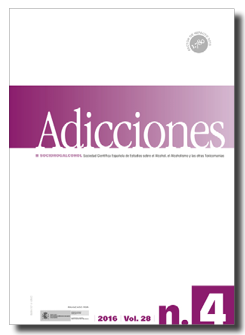Consumo de krokodil por vía oral en España: a propósito de un caso
DOI:
https://doi.org/10.20882/adicciones.828Palabras clave:
Krokodil, Uso de sustancias, Vía oral, Desomorfina.Resumen
El trastorno por uso de krokodil es una de las patologías adictivas con mayores repercusiones orgánicas, principalmente a nivel cutáneo, produciendo una grave y degenerativa necrosis del tejido sanguíneo y muscular. Se trata de un trastorno con escasa prevalencia en España, frente al elevado número de consumidores en otros países como Ucrania o Rusia, si bien se está produciendo una lenta aunque gradual expansión del consumo en países de la Unión Europea y del continente americano. El sencillo proceso de obtención de la sustancia desde la desomorfina, unido a la elevada disponibilidad y bajo coste, configura el proceso de autoabastecimiento de los consumidores. En este artículo revisamos un cuadro clínico, presentando el caso de un paciente que consume krokodil por vía oral.Citas
Abdala, N., Tolstov, Y., Kozlov, A. P., y Heimer, R. (2006). Can homemade injectable opiates contribute to the HIV epidemic among injection drug users in the countries of the former Soviet Union?. Addiction, 101, 731–737.
Demidova, O. V., y Mokhachev, S. O. (2011). Brief report about 68 cases of desomorphine misuse. Narcologiya, 10, 96–98.
Eddy, N, B., Halbach, H., y Braenden, O. J. (1957). Synthetic substances with morphine-like effect. Bulletin of World Health Organization, 569–863.
Eddy, N. B., y Howes, H. (1935). Studies of Morphine, Codeine and their Derivatives X. Desoxymorphine-C, Desoxycodeine-C and their Hydrogenated Derivatives. Journal of Pharmacology and Experimental Theraphy, 55, 257–267.
Gahr, M., Freudenmann, R.W., Hiemke, C., Gunst, I. M., Connemann, B. J., y Schonfeldt-Lecuona, C. (2012). Desomorphine goes crocodile. Journal of Addictive Disorders, 31, 407-412.
Grund, J.P., Latypov, A., y Harris, M. (2013). Breaking worse: the emergence of krokodil and excessive injuries among people who inject drugs in Eurasia. International Journal of Drug Policy, 24, 265-274.
Grund J. P. (2002).A candle lit from both sides: The epidemic of HIV infection in Central and Eastern Europe. In K. McElrath (Eds.), HIV and AIDS: A global view. (pp. 41-68). Westport, CT: Greenwood Press.
Heimer, R. (2013). Patterns of new drug emergence: A comment in light of ‘krokodil”. International Journal of Drug Policy, 24, 275-277. doi:10.1016/j.drugpo.2013.06.003.
Harris, M. (2013). The ‘do-it-yourself’ New Zealand injecting scene: Implications for harm reduction. International Journal of Drug Policy, 24, 281–283.
Kwint, H. M., Kruizinga, S. P., Kaal, M. J. H., y Bootsma, H. P. R. (2013). Gevaarlijke designer drug ‘krokodil’ voor het eerst in Nederland. Pharmaceutisch Weekblad Wetenschappelijk Platform, 7, 128-130.
Matiuk, D. M. (2014). Krokodil: A Monstrous Drug with Deadly Consequences. Journal of Addictive Disorders, 1-14.
Merkinaite, S., Grund, J. P., y Flimpond, A. (2010). Young people and drugs: Next generation of harm reduction. International Journal of Drug Policy, 21, 112-114.
Nogué, S., Amigó, M., y Galicia, M. (2014). Raves, consumo de drogas y asistencia en urgencias. Adicciones, 26, 189-190.
Rhodes, T. (2009). Risk environments and drug harms: A social science for harm reduction approach. International Journal of Drug Policy. 20, 193–201.
Savchuk, S. A., Barsegyan, S. S., Barsegyan, I. B., y Kolesov. G. M. (2008). Chromatographic study of expert and biological samples containing desomorphine. Journal of Analytical Chemistry. 63, 361–370.
Zabransky T, Grund J. P., Latypov A, Otiashvili D, Stuikyte R, Scutelniciuc, O., … Smyrnov, P. (2012). Harm reduction in Central and Eastern Europe. In R. Pates, y D. Riley (Eds.), Harm reduction in substance use and high-risk behaviour: International policy and practice summaries. (pp. 301-321). Oxford: Wiley-Blackwell.








